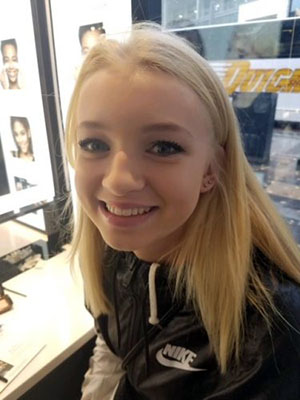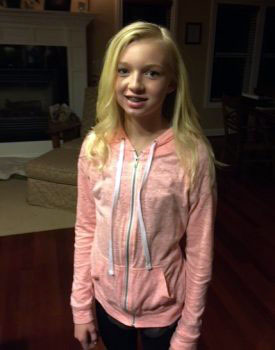How Reese Discovered a Life Worth Living
5.4.2021 | Seattle Children's Press Team
 When Reese Patterson was in sixth grade, she experienced vicious cyberbullying from several of her peers.
When Reese Patterson was in sixth grade, she experienced vicious cyberbullying from several of her peers.
“Every day I would get texts from people who would tell me to kill myself,” Reese said. “When you are told to do that every single day, you actually start to believe it.”
Reese’s mother, Val, recalls trying to work with her school to get the bullying to stop.
“We tried to work with the school, and they said it was out of their hands since it happened outside of the school day,” Val said. “We reported it to police after she overdosed, which became a big joke by some of the kids at school. From there, things got even worse.”
Reese began self-harming through cutting.
“Her school called me when they noticed her cutting,” Val said. “The school suggested I contact Mary Bridge Children’s Hospital, and we went straight there that afternoon. The social worker felt that Reese’s situation wasn’t serious enough and that she’d learn more dangerous behaviors while inpatient. All we were left with was a list of therapists to call.”
Things continued to unravel, as Reese’s cutting became more severe.
“I was sleeping in her room every night and sat outside her open door in the evenings, scared of what she would do,” Val said. “I remember the dark, sad, and empty look in her eyes.”
Reese finally came to a point where she turned to her parents asking for help.
It was then that her parents took her to Seattle Children’s Emergency Department, where a mental health evaluator met with Reese.
“She was honest and admitted to thinking about suicide all the time and that she had a plan,” Val said. “We were so worried they would say, ‘she’s fine and just needs counseling,’ and that we would have to take her home again. Fortunately, we didn’t have to convince them that she needed help, and from there she was admitted to the Psychiatry and Behavioral Medicine Unit (PBMU).”
A Rocky Start on the Road to Healing
 Reese’s stay at the PBMU wasn’t easy.
Reese’s stay at the PBMU wasn’t easy.
“The feeling of knowing my child was going to stay in the hospital without me for a few days was gut wrenching, but it was a relief that she would be safe,” Val said. “She had asked me to stay the first night and of course I did. She was scared, I was scared, and I felt guilty that it got to this point – all the ‘what ifs’ and ‘I should haves’ went through my mind.”
However, Val was grateful knowing that Reese was getting the help she desperately needed.
“Everyone at Seattle Children’s was amazing. They were kind, non-judgmental, and compassionate,” she said. “They explained the process very carefully. We took the parent classes and had appointments with her counselor and psychiatrist.”
While it was originally supposed to be a five day stay, it turned into seven days.
After being discharged, Reese remained in a state of disarray.
“She was still angry and determined to end her life,” Val said. “She was mad that she wasn’t feeling better and felt the hospital visit didn’t work.”
Val found a therapist for Reese, which she at first thought would help alleviate some of Reese’s struggles.
While she was hopeful things would settle down for Reese after seeing a therapist, Reese was still struggling. She attempted to take her life by overdosing on pills.
“We immediately took her to our nearby hospital,” Val said. “That weekend, I took her to her therapy appointment and told her that we were heading back up to Seattle Children’s. Her therapist supported the decision. I was afraid to tell her, but then she hugged me, as if she was relieved to be going.”
Change of Perspective
 Just two weeks after her first stay, Reese was back at the Seattle Children’s PBMU.
Just two weeks after her first stay, Reese was back at the Seattle Children’s PBMU.
“My perspective changed during my second visit,” Reese said. “It was more productive in that I no longer wanted to feel the way I was feeling.”
While Reese was admitted, Val was able to connect with other parents whose children were also in the PBMU through group classes where parents could share their experiences with one another.
Reese was also put on the waiting list to participate in Seattle Children’s Dialectical Behavior Therapy (DBT) program.
DBT is an intensive, outpatient cognitive-behavioral therapy for teens age 13 to 17 who have ongoing trouble regulating emotions and lack effective coping skills and have had thoughts or plans of suicide (suicidal ideation), made suicide attempts or injured themselves on purpose (called nonsuicidal self-injury), such as by cutting or burning their skin.
“There was a waiting period of a few months to get into the program, but looking back, the wait was well worth it,” Val said.
Commitment to Living
 In November 2018, Val received the long-awaited call for Reese’s entry into the DBT program.
In November 2018, Val received the long-awaited call for Reese’s entry into the DBT program.
“It was quite the commitment, especially driving Reese back and forth from our home to Bellevue every Thursday, where the program took place. There was lots of driving, but it was worth every minute.”
It was through the DBT program that Reese met Seattle Children’s psychologist, Dr. Nicole Stettler.
“When I met Reese I knew she was self-harming and experiencing suicidal thoughts,” Stettler said. “She was also approaching the anniversary of a death by suicide by one of her friends, and that was something that was on her mind.”
Stettler worked closely with Reese to evaluate her thoughts and feelings and come up with ways to help her manage her depression and urges to hurt herself.
“A lot of work I did with Reese was in line with what we always target first in DBT – life threatening behavior,” Stettler said. “We look at what is driving suicidal thoughts and self-harm behaviors and start to learn and apply some DBT skills to stop the chain of events of taking actions on thoughts and urges.”
The DBT program consists of four major components: weekly individual therapy; weekly multi-family skill groups, where teens and parents participate in a group setting to learn skills of DBT; and phone coaching between sessions, so that patients have access to their therapist by phone during times of crisis and to help to apply skills where they’re struggling. The final component is more behind the scenes but critical. DBT staff work as a team to make sure they are providing the best care to patients by consulting with team members.
“For Reese, her team included me, a parent coach, skills group leaders, and a psychiatrist, and we would collaborate, and problem solve to deliver the best care possible,” Stettler said. “The goal of DBT is to build a life worth living by taking suicide and self-harm off the table as options, so that we can help put other skills and behaviors in place to reach that life worth living.”
 After a little over a year of weekly DBT sessions, Stettler saw significant changes in Reese’s behavior and knew Reese was ready to graduate from the program.
After a little over a year of weekly DBT sessions, Stettler saw significant changes in Reese’s behavior and knew Reese was ready to graduate from the program.
“I recall being so proud of her,” Stettler said. “She wrote me a letter that I still have a copy of that was incredibly moving in that she shared how much DBT and the work we did together impacted her life.”
Val is grateful for the DBT program and what it did for Reese and her family.
“As a family we learned to communicate better, cope with small and large challenges, learned mindfulness techniques, and strategies to help ourselves and others,” Val said. “It didn’t fix the bullying situation for Reese, but it armed her with the skills to cope with her feelings, manage her emotions, and let go of the stuff that doesn’t matter.”
Today, Reese is thriving.
“The DBT program changed our lives – and saved Reese’s,” Val said.
Reese wants others who may be struggling with mental health issues to know that the only person who can truly help you is yourself.
“No one can change your mindset other than you,” Reese said. “The biggest takeaway I received from my experiences is that nothing is going to change unless you’re ready to make that change.”